|
The pictures are arranged
by Family. Return to
Native Plants page.
Press Release: "The Flower Mound, Flower Mound, Texas: A History
And Field Guide To The Flowers And Grasses “ Enters A Literary Land |
__________________________________________________________________________________________________
GRASSES |
|
POACEAE - Grass Family |
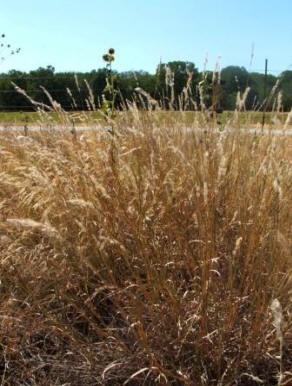 Silver
bluestem - Bothriochloa
laguroides Silver
bluestem - Bothriochloa
laguroides
Silver bluestem reaches up to 42" in height & is a warm season perennial
bunchgrass. The silver seed heads glisten in the sun when the
grass is swaying in the wind on a summer day. This grass would
make an attractive accent in a garden, especially in a breezy garden! |
|
 Hairy
grama - Bouteloua hirsuta Hairy
grama - Bouteloua hirsuta
Hairy grama is a warm season perennial bunchgrass. It provides
good forage for cattle & wildlife.
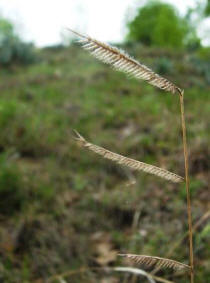 Although this grass doesn't
reach the proportions of other bunchgrasses, it makes for an attractive
planting interspersed amongst the larger bunchgrasses & wildflowers. Although this grass doesn't
reach the proportions of other bunchgrasses, it makes for an attractive
planting interspersed amongst the larger bunchgrasses & wildflowers.
|
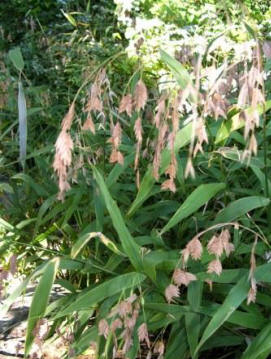 Inland
seaoats - Chasmanthium latifolium Inland
seaoats - Chasmanthium latifolium
This perennial grass loves the shade. It grows along streams &
moist woodlands. Seaoats provides excellent forage for wildlife. It makes an attractive ornamental grass for landscaping. This is a
good grass to plant in a shady spot for your backyard wildlife habitat. It is a larval host for several varieties of skipper
butterflies.
|
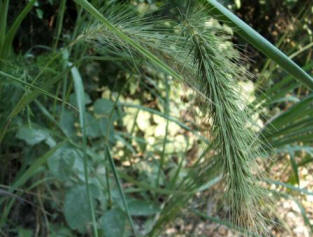 Canada
wildrye - Elymus
canadensis Canada
wildrye - Elymus
canadensis
Canada wildrye grows in shady spots or openings in the woods.
It provides good early grazing for livestock & fair forage for wildlife
such as deer. Many species of small mammal & birds eat the grain &
use it for nesting material & cover. The seed heads make an
attractive accent to a garden. This grass can help fill in those
shady spots in your yard where you can't get other things to grow.
|
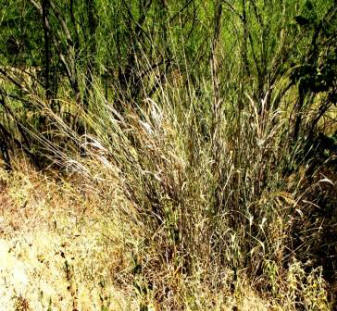 Switchgrass - Panicum virgatum Switchgrass - Panicum virgatum
Switchgrass is a dominant bunchgrass found in the original tall grass
prairie and is one of the "big four" along with Indiangrass, Little
bluestem & Big bluestem. It is a perennial that grows in large
clumps, which makes it good for soil erosion. It would be perfect
to fill in an unused corner of a lot. Wildlife use Switchgrass
for nesting & denning material, & it serves as a larval host for many
different butterfly species.
|
  Indiangrass - Sorghastrum nutans Indiangrass - Sorghastrum nutans
This grass is one of the "big four" native grasses of the original
tall grass prairie. It can be found in the Cross Timbers region at
undisturbed sites. It provides good soil erosion control, makes a
nice accent grass for landscaping, provides seed for wildlife, is an
important forage grass & is an indicator of good range conditions.
|
| This listing of native
plants of the Cross Timbers eco-region is not comprehensive. This
is merely a compilation of some plants that can be found locally in
lawns, parks, development sites, and natural areas. If you keep
your eyes to the ground, you'll be surprised at what you might find!
With water conservation in our urban areas
becoming increasingly more important, native plants in our landscapes
can help us save our precious water. Native plants grow naturally
in our soils, climate & unpredictable weather. They are
drought-tolerant and need little attention. Some of these native
plants may not be available in most local nurseries, however, you might
try calling nurseries that specialize in native plants. You always
have the option of propagating these plants from seed or vegetatively. If nothing else, knowing some native plants will help you appreciate
their role in our environment and urban settings.
Some good resources for ID & to learn
more about native plants of Texas are:
Shinners & Mahler's Illustrated Flora of North Central Texas
by George M. Diggs, Jr., Barney L. Lipscomb,
& Robert J. O'Kennon
Wildflowers of Texas by Geyata Ajilvsgi
Wildflowers of the Texas Hill Country by Marshall Enquist
Texas Wildflowers by Campbell & Lynn Loughmiller
Trees of North Texas by Robert A. Vines
Trees of Texas by Carmine Stahl & Ria McElvaney
Grasses of the Texas Hill Country by Brian & Shirley
Loflin
Common Texas Grasses: An Illustrated Guide by Frank W.
Gould
Texas Wildscapes: Gardening for Wildlife by
Noreen Damude and Kelly Conrad Bender
Landscaping with Native
Plants of Texas by George Oxford Miller
How to Grow Native Plants of Texas & the Southwest by Jill
Nokes
Find out how community volunteers can take
an area that was formerly neglected and overgrown with invasive, exotic
privet and return the site to the Eastern Cross Timbers ecosystem. Visit the Molly
Hollar Wildscape website to learn more.
Return to Native
Plants page.
|